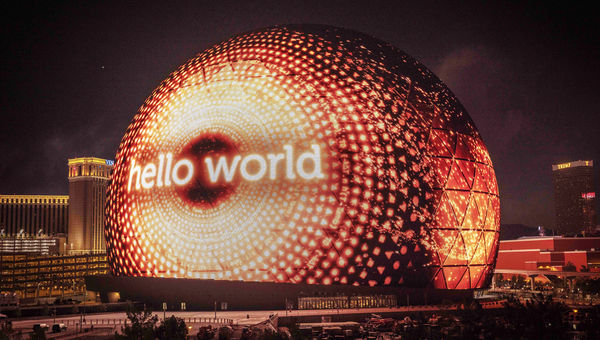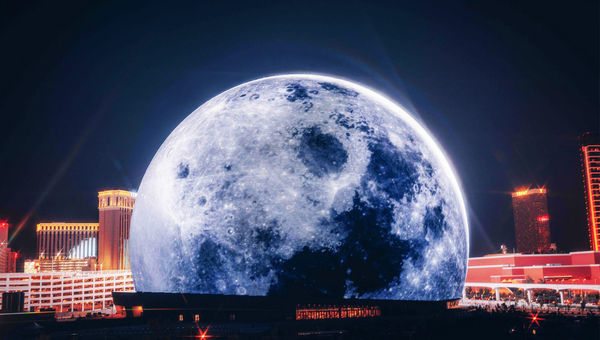
Paul Szydelko
Even on a night of fireworks over a city known for audacious light displays, Sphere made a spectacular first impression with the debut of its exterior capabilities on July 4.
Sphere's 580,000-square-foot exterior, what developers call the "exosphere" and billed as the world's largest LED screen, instantly transformed the Las Vegas skyline and lit up social media posts.

Sphere lit up the Las Vegas night sky for the first time on July 4 with the message, "hello world." Photo Credit: Sphere Entertainment
A "hello world" message was followed by sparkling fireworks and stars-and-stripes animations. Diverse content included underwater scenes, the lunar surface, basketballs celebrating the NBA Summer League in town, a haunting eye and mysterious portals.
Creating the vividly textured displays are about 1.2 million LED pucks (each about the size of an actual hockey puck), spaced eight inches apart. Each puck contains 48 LED diodes, with each diode capable of displaying 256 million colors.
"The exosphere is more than a screen or a billboard. It is living architecture, and unlike anything that exists anywhere in the world," said Guy Barnett, senior vice president of brand strategy and creative development for the project.
"[The] show provided a glimpse of the exosphere's captivating power and the possibilities for artists, partners and brands to create compelling and impactful stories to connect with audiences in new ways," Barnett said.
The exosphere will be featured as part of Sphere's opening in September with U2 in concert and in October when the "Postcard from Earth" film debuts. Sphere is also well positioned to capture global attention during the inaugural Formula 1 Las Vegas Grand Prix in November.
The 18,500-seat Sphere, a development of Madison Square Garden Entertainment, reportedly cost $2.3 billion. It is attached to the Venetian Expo via a covered walkway.
In addition to hosting concerts, films and occasional sports events such as boxing or mixed martial arts, Sphere is also expected to be used for large-scale events and presentations by trade shows and meetings groups.
What does the future hold for Sphere?
"It's an amazing addition to our skyline," said Aaron Berger, executive director of the Neon Museum. "This is the largest spherical building in the world with next-generation technology inside and out. It will be a photo/video background for quite some time."
Berger says he's curious whether "form follows function or function follows form" as Sphere finds its place among the city's meetings spaces as well as its arts and entertainment landscape.

Full moon over Vegas? Nope, just one of the many images that have appeared on the exterior of Sphere since it debuted on July 4. Photo Credit: Sphere Entertainment
"Las Vegas is an amazing town for experimentation, from architecture to entertainment to cuisine. Las Vegas is perfectly suited for Sphere, as much as Sphere being perfectly suited for Las Vegas, because of our ability to push boundaries and test an audience's appetite for a new offering," Berger said.
When the Mirage was being built in the late 1980s, many observers thought the property's multimillion-dollar villas and high-end offerings would distract gamblers and doom it, Berger said. "Yet they were operating in the black [after] a year and ultimately changed the concept of the megaresort," he said.
"Sphere may just change the concept of performing arts spaces. Las Vegas is the place to test that."
Berger would like to see Sphere promote the arts or uniquely Vegas offerings along with its commercial applications.
"That would root the Sphere in Las Vegas in a very special and intentional way," Berger said.
"I would love to see an artist-in-residency program come to Sphere. Allowing tech-based artists the opportunity to create digitally based art that can range from a cityscape image that makes Sphere 'disappear' to immersive graffiti. There's tremendous potential for artistic application here," Berger said.
Michael Green, a history professor at the University of Nevada, Las Vegas, said the Sphere is different because most instantly recognized structures in the tourist corridor are hotels.
"The Sphere obviously is part of the Venetian/Las Vegas Sands property, but not in itself the hotel," Green said. "It does tend to bring to mind the fountains at the Bellagio or the volcano at the Mirage or the statues at Caesars, and it may well stand out even more. It's also designed to have something inside in a way that we don't think so much of the fountains, for example."
Green said he expects to see more ambitious uses of LED throughout the Strip.
"Neon was so closely associated with Las Vegas, while LED has been around and prominent in other places," Green said. "It will be interesting to see how Las Vegas takes advantage of the opportunities LED presents ... and it will."
Berger noted that Circa Resort & Casino's "use of LED references neon lighting. Neon is nostalgic, but artists and sign-makers have proven it's also timeless."
Whether it's through neon or LED or other ways, Las Vegas has a long tradition of effective branding and beguiling attention-grabbers.
"Creative, innovative minds are always at work to find ways to draw customers in or at the very least pique their interest or marvel at the 'wow factor,'" Berger said. "LED is what we have now, but what's next in a city that is constantly fighting for a visitor's attention?"